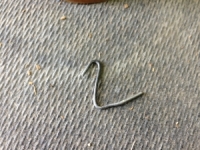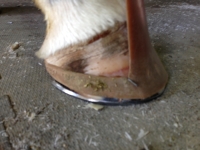Many years ago, John Patterson Sr. kept asking me to drill holes in the back feet on some of his trotters, usually between the first and second nail and into the border between hoof and shoe (Fig. 1). This was done after having already trimmed and reshod that hoof.
Much earlier in my shoeing career I didn't ask questions as much as I do now and just did what was asked of me. I got over that by very quickly learning that horse trainers are a wealth of information about shoeing.
Finally, I asked "Big John" why we were drilling the holes in feet. He smirked at me with his wry grin and said "scalper clips." I had many images go through my mind of what a scalper clip would look like and how it worked, none of which were correct. A scalper clip is a simple wire (Fig. 2), bent in a shape that will go into the hole we made and hold the scalper down while the horse is training (Fig. 3).
 (Photos by the author) Fig. 1: A horseman drills a hole in a horse's back foot in order to insert a scalper clip.
(Photos by the author) Fig. 1: A horseman drills a hole in a horse's back foot in order to insert a scalper clip. Fig. 2: A scalper clip can be made from a welding wire or a coat hanger.
Fig. 2: A scalper clip can be made from a welding wire or a coat hanger.  Fig. 3: A scalper clip secures the scalper down while the horse is training.
Fig. 3: A scalper clip secures the scalper down while the horse is training.
Sometimes a horse will scalp so subtly that it causes more aggravation than damage. They will scuff up the hoof or hairline if they don't have on scalpers and knock up the scalper if they do wear them. Those types are the ones Patterson was using scalper clips on.
These clips are easy to make; a farrier can use a standard 1/8-inch welding wire or even just a coat hanger will do. I use a 1/8-inch drill bit, and starting at the border between shoe and hoof, I angle the drill bit slightly toward the shoe side so as not to drill too deeply into the hoof. Your farrier will almost certainly know what you are asking for, and if you are already using them, he will probably notice the grooves (it's not a true hole) left behind from last time.
Of course, as a farrier, I prefer to try altering the shoes to prevent the scalping; however, sometimes it is the case that a trotter is going very well the way it is shod, and the scalping is just a mild annoyance.
As we all know, when trotters are traveling very well, it is often quite difficult for horsemen and farriers to pull the trigger on changes to that shoeing package. I feel compelled to credit a friend of mine here. Jimmy Takter once told me (and I paraphrase through Marcus Johansson) that "no horse is perfect; they can always be better."
I never forgot that statement. I believe it completely, and am grateful to have heard it from someone so successful in the sport. The fact that we were shoeing Pampered Princess at the time drove home the point quite nicely. Takter rarely stands pat.
However, if you finally have that difficult trotter where you want it, and are only dealing with a little scalping, this is a quick and easy fix.
Veteran Standardbred farrier Steve Stanley of Lexington, Ky., authors a monthly column for Hoof Beats, the official harness racing publication of the U.S. Trotting Association. The American Farriers Journal Editorial Advisory Board member offers plenty of practical advice that will be of special interest regardless of the type of horses that you work with. Click here to read more from Steve Stanley's Hoof Beats series.








Post a comment
Report Abusive Comment